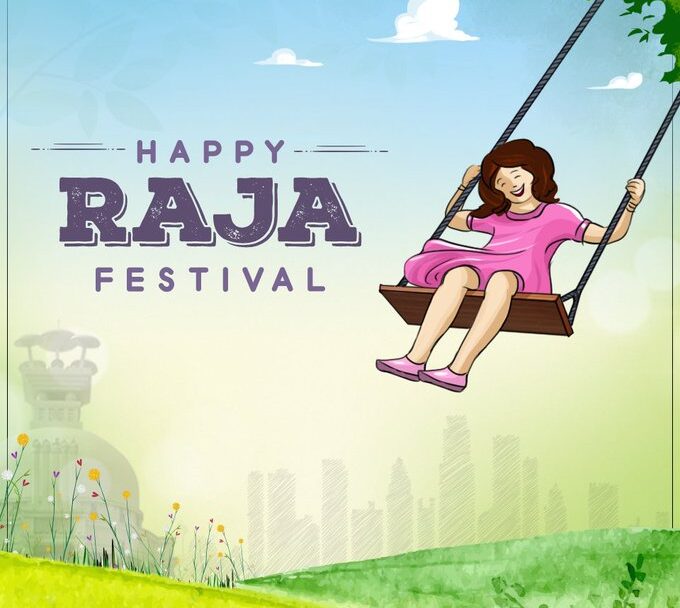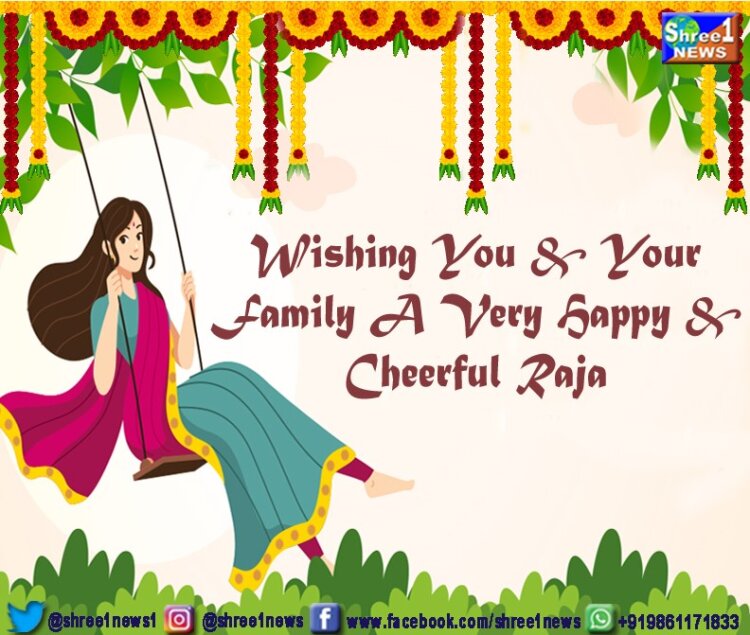The term “Raja” derives from the Sanskrit root word “Rajaswala,” which means “menstruating.” The Raja festival commemorates menstruation and is held during the month of Asadha, which falls in the second week of June. It is the beginning of the Solar month ‘Mithuna’ as per the Odia calendar and so, it is also named ‘Mithuna Sankranti’. Raja is an agrarian celebration that marks the start of the agricultural season.
Raja honors mother Earth’s feminine spirit. People think that mother Earth, like women, goes through menstruation, and that the event is held to provide her with the rest that women require.
The parched land receives much-needed water for agricultural production. This celebration commemorates the arrival of the monsoon rains. This first shower of monsoon rain is viewed figuratively as Mother Earth’s menstruation, or Raja. Raja is commemorated to highlight the significance and symbolic relation of the first rain for crop production.
Rainfall, like menstruation, is a sign of fertility in women, and it improves agricultural output in the land. Mother Earth menstruates in the same way that women do.
This three-day event commemorates Mother Earth’s menstrual period and is celebrated with fervor and excitement. To give Mother Earth a total vacation, no agricultural activity is done. During this time, the land is left unspoiled and resting.
According to Odia tradition, ‘Bhudevi’ is the wife of Lord Jagannath, who is worshipped as the “Lord of the Whole Universe.” Bhudevi, a version of Goddess Lakshmi, menstruates during this time. It is considered that the essence of the Goddess can be found in all the girls and women; therefore they are worshipped during this period.
In the regional language Odia, the first day of the festival is known as ‘Sajabaja’. On this day, dwellings are cleaned and all preparations are made, such as arranging food, grinding spices, and so on.

The event starts with ‘Pahili Raja,’ or the first day of the Raja festival, which falls on the last day of the ‘Jyaistha’ month. The following day, the first day of the Odia calendar’s ‘Asadha’ month, ‘Raja Sankranti’ or ‘Mithuna Sankranti’ is celebrated. The third day of this event is known as the ‘Basi Raja’ or ‘Bhudaaha’. The celebration concludes with ‘Basumata Raja’ on the fourth day. On this day, women and girls bathe with turmeric, clay, and other earth-related substances to honor ‘Bhumi,’ or the Earth. This special bath is termed ‘Basumata Snana’.
During this festival, women and girls are not permitted to work in order for them to rest completely. They go out, perform various traditional games, and enjoy the celebration anyway they choose. Young ladies dress up in new outfits and put ‘alata’ on their feet. Married women wear jewelry and use the red vermilion’sindoor’. The most characteristic and lovely aspect of the Raja celebration is the rope swings, also known as ‘Raja Doli’, which are normally made of natural materials like as tree leaves, jute, garments, and so on and are linked to large banyan trees. They swing and sing folk tunes in this Raja Doli. Females congregate to celebrate the event by consuming delightful goodies such as sweets and ‘Pithas,’ a traditional cake made on this occassion.
Poda Pitha is Raja’s most famous and cherished Pitha. Other Odia Pithas such as Manda Pitha, ‘Kakara Pitha,’ ‘Arisha Pitha,’ ‘Chakuli Pitha,’ and ‘Chandrakala Pitha’ are also prepared.
Every day, Lord Jagannath is also offered ‘Poda Pitha,’ which is thought to be his favorite food. The sweetened beetle leaf, ‘Raja Pana,’ is an integral feature of the event. During this festival period, girls are not permitted to engage in any activity that may give them discomfort, injury, or exhaustion. As a result, they are not permitted to perform kitchen and household tasks such as cooking, sweeping the floor, combing hair, and so on. To honor Mother Earth, no one is permitted to walk barefoot because it may inflict on the earth’s surface causing pain to Mother Earth.
The Significance Of The Raja Festival
Menstruation is typically regarded as impure, and women and girls are regarded as impure during this time. Many activities are prohibited for them. The Raja celebration, on the other hand, takes a totally different approach to this natural female process. This celebration honors women’s special attributes, such as fertility, and she is recognized as the creator of the world, earning her a greater social rank. Menstruation is so taboo in Indian society that there is no open conversation about it. Menstruation is kept private even within families. The accompanying taboos, stigmas, social norms, and misconceptions about menstruation form a vicious cycle in which females feel discriminated against and alienated from society and males see females as impure and inferior, which gives rise to a vicious cycle in which females feel discriminated against and alienated from society and males regard females as impure and inferior, which gives rise to the social anomaly.
However, the Raja Festival takes this crucial facet of women outside of the confines of the home and gives it social acceptance. This festival raises awareness and starts a social dialogue regarding menstruation, which helps women’s status in society. It shatters society’s conservatism, in which menstruation is socially inappropriate and viewed as a taboo. The Raja festival provides an opportunity for young girls to learn about menstruation. Celebrating Raja contributes to the normalization of menstruation in society, hence putting a stop to menstruation-based discrimination.
Odisha stands out in order to commemorate the menstrual cycle, delivering the message that women are not impure during their periods.









 Finance
Finance






